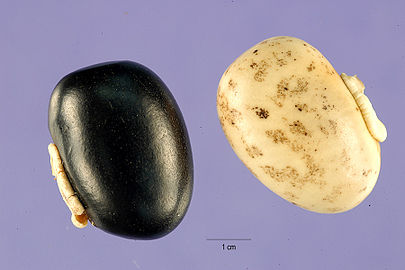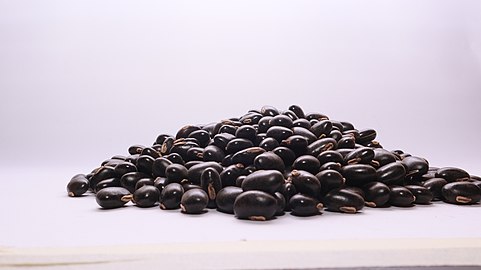Mucuna pruriens
| Mucuna pruriens | |
|---|---|

| |
| Mucuna pruriens inflorescence | |
| Scientific classification | |
| Kingdom: | Plantae |
| Clade: | Tracheophytes |
| Clade: | Angiosperms |
| Clade: | Eudicots |
| Clade: | Rosids |
| Order: | Fabales |
| Family: | Fabaceae |
| Subfamily: | Faboideae |
| Genus: | Mucuna |
| Species: | M. pruriens
|
| Binomial name | |
| Mucuna pruriens | |
| Synonyms[1] | |
| |
Mucuna pruriens is a tropical legume native to Africa and tropical Asia and widely naturalized and cultivated.[2] Its English common names include monkey tamarind, velvet bean, Bengal velvet bean, Florida velvet bean, Mauritius velvet bean, Yokohama velvet bean, cowage, cowitch, lacuna bean, and Lyon bean.[2] The Tshivenda/Venda language name is Vhulada.
The plant is notorious for the extreme itchiness it produces on contact,[3] particularly with the young foliage and the seed pods. It also produces many medium-sized red swollen bumps along with the itching. It has agricultural and horticultural value and is used in herbalism.
Description
[edit]Mucuna pruriens is an annual climbing shrub with long vines that can reach over 15 metres (50 feet) in length. When the plant is young, it is almost completely covered with fuzzy hairs, but when older, it is almost completely free of hairs. The leaves are tripinnate, ovate, reverse ovate, rhombus-shaped or widely ovate. The sides of the leaves are often heavily grooved and the tips are pointy. In young specimens, both sides of the leaves have hairs. The stems of the leaflets are 2–3 millimetres (1⁄16–1⁄8 inch) long. Additional adjacent leaves are present and are about 5 mm (1⁄4 in) long.
The flower heads take the form of axially arrayed panicles. They are 15–32 centimetres (6–13 in) long and have two or three, or many flowers, which can be white, lavender, or purple. The accompanying leaves are about 12.5 mm (1⁄2 in) long; the flower stand axes are from 2.5–5 mm (1⁄8–3⁄16 in). The bell is 7.5–9 mm (5⁄16–3⁄8 in) long and silky. The sepals are longer or of the same length as the shuttles. The crown is purplish or white. The flag is 1.5 mm (1⁄16 in) long. The wings are 2.5–3.8 cm (1–1+1⁄2 in) long.
In the fruit-ripening stage, a 4–13 cm (2–5 in) long, 1–2 cm (3⁄8–3⁄4 in) wide, unwinged, leguminous fruit develops. There is a ridge along its length and the husk is covered in loose, orange hairs that cause a severe itch if they contact skin.[4][5] The pods carry up to seven seeds, which are shiny black or brown drift seeds. They are flattened uniform ellipsoids, 1–1.9 cm (3⁄8–3⁄4 in) long, .8–1.3 cm (3⁄8–1⁄2 in) wide and 4–6.5 cm (2–3 in) thick. The hilum, the base of the funiculus (connection between placenta and plant seeds) is a surrounded by a significant arillus (fleshy seed shell). The dry weight of the seeds is 55–85 grams (2–3 ounces)/100 seeds.[6]
-
19th-century Japanese illustration
-
Flowers (colored engraving)
-
Velvet bean in Kawal Wildlife Sanctuary, India
-
Seed pod, the hairs of which cause a dire itch
-
Mature seed pods
-
Seeds of two different colors
-
Pile of seeds
Chemistry
[edit]The seeds of the plant contain about 3.1–6.1% L-DOPA.[7] M. pruriens var. pruriens has the highest content of l-DOPA. An average of 52.11% degradation of l-DOPA into damaging quinones and reactive oxygen species was found in seeds of M. pruriens varieties.[8]
Taxonomy
[edit]Subspecies
[edit]- Mucuna pruriens ssp. deeringiana (Bort) Hanelt
- Mucuna pruriens ssp. pruriens[5]
Varieties
[edit]- Mucuna pruriens var. hirsuta (Wight & Arn.) Wilmot-Dear[2]
- Mucuna pruriens var. pruriens (L.) DC.[9]
- Mucuna pruriens var. sericophylla[2]
- Mucuna pruriens var. utilis (Wall. ex Wight) L.H.Bailey is the non-stinging variety grown in Honduras.[10]
Itch-inducing properties
[edit]The hairs lining the seed pods contain serotonin and the protein mucunain, which cause severe itching when the pods are touched.[3][7][11] The calyx below the flowers is also a source of itchy spicules and the stinging hairs on the outside of the seed pods are used in some brands of itching powder.[3][12] Scratching the exposed area can spread the itching to other areas touched, which can cause blindness if in the area of the eyes.[13] Once this happens, the subject tends to scratch vigorously and uncontrollably and for this reason the local populace in northern Mozambique refer to the beans as "mad beans" (feijões malucos). The seed pods are known as "Devil Beans" in Nigeria.[14]
Uses
[edit]In many parts of the world, M. pruriens is used as an important forage, fallow and green manure crop.[15] Since the plant is a legume, it fixes nitrogen and fertilizes soil. In Indonesia, particularly Java, the beans are eaten and widely known as 'Benguk'. The beans can also be fermented to form a food similar to tempeh and known as Benguk tempe or 'tempe Benguk'.
M. pruriens is a widespread fodder plant in the tropics. To that end, the whole plant is fed to animals as silage, dried hay or dried seeds. M. pruriens silage contains 11–23% crude protein, 35–40% crude fiber, and the dried beans 20–35% crude protein. It also has use in the countries of Benin and Vietnam as a biological control for problematic Imperata cylindrica grass.[15] M. pruriens is said to not be invasive outside its cultivated area.[15] However, the plant is invasive within conservation areas of South Florida, where it frequently invades disturbed land and rockland hammock edge habitats. Cooked fresh shoots or beans can also be eaten. The plant contains relatively high (3–7% dry weight) levels of l-DOPA,[16] which some people are sensitive to; it can cause nausea, vomiting, cramping, arrhythmias, and hypotension.
Traditional medicine
[edit]The plant and its extracts have long been used in tribal communities as an antidote for snakebite. More recently, its effects against bites by Naja (cobra),[17] Echis (saw-scaled viper),[18] Calloselasma (Malayan pit viper), and Bungarus (krait) species have been studied.[citation needed] It has been investigated as a treatment for Parkinson's disease[19] due to its high l-DOPA content,[20][16] while the seeds have been recognized for their ability to significantly alleviate neurotoxicity associated with the condition.[21]
The seeds have also been used for treating mood disorders, as well as for sexual dysfunction in Tibb-e-Unani[22] and Ayurvedic medicine.[citation needed]
The dried leaves of M. pruriens are sometimes smoked.[why?][5]
See also
[edit]References
[edit]- ^ "The Plant List: A Working List of All Plant Species". Retrieved 8 March 2015.
- ^ a b c d "Mucuna pruriens". Germplasm Resources Information Network. Agricultural Research Service, United States Department of Agriculture. Retrieved 8 March 2015.
- ^ a b c Andersen HH, Elberling J, Arendt-Nielsen L (September 2015). "Human surrogate models of histaminergic and non-histaminergic itch" (PDF). Acta Dermato-Venereologica. 95 (7): 771–7. doi:10.2340/00015555-2146. PMID 26015312.
- ^ Reddy VB, Iuga AO, Shimada SG, LaMotte RH, Lerner EA (April 2008). "Cowhage-evoked itch is mediated by a novel cysteine protease: a ligand of protease-activated receptors". The Journal of Neuroscience. 28 (17): 4331–5. doi:10.1523/JNEUROSCI.0716-08.2008. PMC 2659338. PMID 18434511.
- ^ a b c Rätsch, Christian (1998). Enzyklopädie der psychoaktiven Pflanzen. Botanik, Ethnopharmakologie und Anwendungen. Aarau: AT-Verl. p. 15. ISBN 978-3-85502-570-1.
- ^ "Factsheet - Mucuna pruriens". www.tropicalforages.info. Archived from the original on 2008-05-15. Retrieved 2008-02-23.
- ^ a b Dart, Richard C. (2004). Medical Toxicology - Google Book Search. Lippincott Williams & Wilkins. ISBN 978-0-7817-2845-4. Retrieved 2008-03-15.
- ^ Pulikkalpura H, Kurup R, Mathew PJ, Baby S (June 2015). "Levodopa in Mucuna pruriens and its degradation". Scientific Reports. 5 (1): 11078. Bibcode:2015NatSR...511078P. doi:10.1038/srep11078. PMC 4460905. PMID 26058043.
- ^ Picapica
- ^ "CANADA: Hotline will help health care officials dealing with opioid cases andrsaquo; Medicine Hat News". drugpolicycentral.com. Archived from the original on 2015-04-22. Retrieved 2017-08-04.
- ^ YERRA RAJESHWAR, MALAYA GUPTA and UPAL KANTI MAZUMDER (2005). "In Vitro Lipid Peroxidation and Antimicrobial Activity of Mucuna pruriens Seeds". Iranian Journal of Pharmacology and Therapeutics. 4 (1): 32–35.
- ^ G. V. Joglekar, M. B. Bhide J. H. Balwani. An experimental method for screening antipruritic agents. British Journal of Dermatology. Volume 75 Issue 3 Page 117 - March 1963
- ^ The Complete Guide to Edible Wild Plants. United States Department of the Army. New York: Skyhorse Publishing. 2009. p. 129. ISBN 978-1-60239-692-0. OCLC 277203364.
{{cite book}}: CS1 maint: others (link) - ^ "Devil's bean: Wonderful health provider!". The Sun Nigeria. 2018-11-15. Retrieved 2020-01-18.
- ^ a b c "Factsheet - Mucuna pruriens". www.tropicalforages.info. Archived from the original on 2008-05-15. Retrieved 2008-05-21.
- ^ a b Cohen, Pieter A.; Avula, Bharathi; Katragunta, Kumar; Khan, Ikhlas (1 October 2022). "Levodopa Content of Mucuna pruriens Supplements in the NIH Dietary Supplement Label Database". JAMA Neurology. 79 (10): 1085–1086. doi:10.1001/jamaneurol.2022.2184. PMC 9361182. PMID 35939305.
- ^ Tan NH, Fung SY, Sim SM, Marinello E, Guerranti R, Aguiyi JC (June 2009). "The protective effect of Mucuna pruriens seeds against snake venom poisoning". Journal of Ethnopharmacology. 123 (2): 356–8. doi:10.1016/j.jep.2009.03.025. PMID 19429384.
- ^ "Characterization of the factor responsible for the antisnake activity of Mucuna Pruriens' seeds" (PDF). Journal of Preventive Medicine and Hygiene. 40: 25–28. 1999. Archived from the original (PDF) on 2010-09-23. Retrieved 2011-03-23.
- ^ Katzenschlager R, Evans A, Manson A, Patsalos PN, Ratnaraj N, Watt H, Timmermann L, Van der Giessen R, Lees AJ (December 2004). "Mucuna pruriens in Parkinson's disease: a double blind clinical and pharmacological study". Journal of Neurology, Neurosurgery, and Psychiatry. 75 (12): 1672–7. doi:10.1136/jnnp.2003.028761. PMC 1738871. PMID 15548480.
- ^ Cassani E, Cilia R, Laguna J, Barichella M, Contin M, Cereda E, Isaias IU, Sparvoli F, Akpalu A, Budu KO, Scarpa MT, Pezzoli G (June 2016). "Mucuna pruriens for Parkinson's disease: Low-cost preparation method, laboratory measures and pharmacokinetics profile". Journal of the Neurological Sciences. 365: 175–80. doi:10.1016/j.jns.2016.04.001. PMID 27206902.
- ^ Singh, Surya P.; Gedda, Mallikarjuna R.; Jadhav, Jyoti P.; Patil, Ravishankar R.; Zahra, Walia; Singh, Saumitra S.; Birla, Hareram; Rai, Sachchida N. (2017). "Mucuna pruriens Protects against MPTP Intoxicated Neuroinflammation in Parkinson's Disease through NF-κB/pAKT Signaling Pathways". Frontiers in Aging Neuroscience. 9: 421. doi:10.3389/fnagi.2017.00421. ISSN 1663-4365. PMC 5742110. PMID 29311905.
- ^ Amin. KMY; Khan. MN; Rahman, Hakim Syed Zillur; et al. (1996). "Sexual function improving effect of Mucuna pruriens in sexually normal male rats". Fitoterapia. 67 (1): 53–58. Archived from the original on 2011-06-25. Retrieved 2007-05-22.
The seeds of M. pruriens are used for treating sexual dysfunction in Tibb-e-Unani (Unani Medicine), the traditional system of medicine of Indian subcontinent
External links
[edit]![]() Media related to Mucuna pruriens at Wikimedia Commons
Media related to Mucuna pruriens at Wikimedia Commons
- Mucuna pruriens (U.S. Forest Service)
- www.hort.purdue.edu Crop Fact Sheets
- Mucuna pruriens (Tropical Forages)
- Mucuna pruriens protects against snakebite venom
- Mucuna pruriens var. utilis (Photos)
- Chemicals in: Mucuna pruriens (L.) DC. (Dr. Duke's Phytochemical and Ethnobotanical Databases)
- Lycaeum
- Mucuna pruriens a Comprehensive Review
- Mucuna pruriens Seed L-DOPA Content on the Basis of Seed Color
- Research Paper Showing Quantitative Phytochemical Analysis
- Mucuna pruriens (Kapikacchu, Atmagupta) entry in Caldecott







